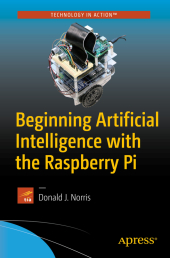 Neuerscheinungen 2017Stand: 2020-02-01 |
Schnellsuche
ISBN/Stichwort/Autor
|
Herderstraße 10
10625 Berlin
Tel.: 030 315 714 16
Fax 030 315 714 14
info@buchspektrum.de |

Donald J. Norris
Beginning Artificial Intelligence with the Raspberry Pi
1st ed. 2017. xxi, 369 S. 64 SW-Abb., 122 Farbabb. 235 mm
Verlag/Jahr: SPRINGER, BERLIN; APRESS 2017
ISBN: 1-484-22742-5 (1484227425)
Neue ISBN: 978-1-484-22742-8 (9781484227428)
Preis und Lieferzeit: Bitte klicken
Gain a gentle introduction to the world of Artificial Intelligence (AI) using the Raspberry Pi as the computing platform. Most of the major AI topics will be explored, including expert systems, machine learning both shallow and deep, fuzzy logic control, and more!
AI in action will be demonstrated using the Python language on the Raspberry Pi. The Prolog language will also be introduced and used to demonstrate fundamental AI concepts. In addition, the Wolfram language will be used as part of the deep machine learning demonstrations.
A series of projects will walk you through how to implement AI concepts with the Raspberry Pi. Minimal expense is needed for the projects as only a few sensors and actuators will be required. Beginners and hobbyists can jump right in to creating AI projects with the Raspberry PI using this book.
What You´ll Learn
What AI is and-as importantly-what it is not
Inference and expert systems
Machine learning both shallow and deep
Fuzzy logic and how to apply to an actual control system
When AI might be appropriate to include in a system
Constraints and limitations of the Raspberry Pi AI implementation Who This Book Is For
Hobbyists, makers, engineers involved in designing autonomous systems and wanting to gain an education in fundamental AI concepts, and non-technical readers who want to understand what AI is and how it might affect their lives.
Chapter 1 title: Introduction to Artificial Intelligence - Explain what AI is and is not. - Establish why it is important and how it may be used - What is the state of AI today and how is it developing? Chapter 2 title: Basic AI Concepts - What is inference? - Introduce the concept of the expert system - What is machine learning? Detail the various branches of ML. - Is fuzzy logic really fuzzy? Explain how it is used in real-world control situations Chapter 3 title: The Raspberry Pi and an Expert System - Introduce the Prolog language - Demonstrate a simple expert system running on the Raspberry Pi with Prolog - Simple Q&A demonstration using an expert system Chapter 4 title: Some Simple AI Games - Introduce the Python language to implement several games demonstrating AI behavior - Paper, rock, scissors - Nim (or sometimes referred to as pepple pickup) - The "wave" demonstrating emergent behavior - "Tic-Tac-Toe" and an expert system Chapter 5 title: Fuzzy Logic Control Project - Use Prolog to create FL sets - Integrate expert system knowledge into the FL control algorithms - Demonstrate FL control using a Raspberry Pi with a light sensor and LED indicators Chapter 6 title: Machine Learning - Shallow - Explore shallow learning - Simple demonstration about learning a favorite color - Naive Bayesian decisions and decision trees Chapter 7 title: Machine Learning - Deep with Neural Networks- Explore deep learning - Simple two-layer neural network - Neural network demonstration using Python
Chapter 8 title: Machine Learning - Deep with Genetic Algorithms - Explore how to create a genetic algorithm - Implement a "longest-path" algorithm for a virtual robot - Demonstrate the algorithm using a Raspberry Pi controlled "Boe-bot" robotic car
Chapter 9 title: Computer Vision - What is computer vision and how is it related to AI? - Introduction to the Wolfram Language (WL) and Mathematica as run on the Raspberry Pi - Several CV demonstrations using WL/Mathematica using the PiCamera as well raw image data from the Wolfram Research servers
Chapter 10 title: Subsumption - What is subsumption? - Explanation of a virtual subsumption robotic model - An actual subsumption demonstration using the Boe-bot robot from chapter 8.


